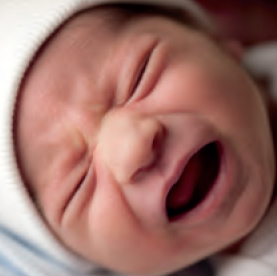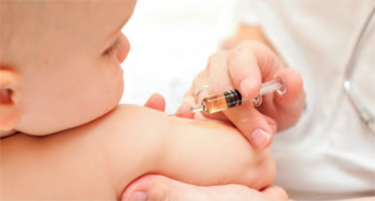It was a centuries-old notion that had profound ramifications for medicine: Infants, especially those born prematurely, felt little or no pain. As recently as the late 1970s, physicians in the United States and other countries used pain-killing medications on infants only sparingly; the common practice was to provide infants with a sucrose solution to quiet and soothe. Even medical procedures like lancing and needle sticks were routinely performed with little or no anesthetic or similar agents.
 Although the 1980s saw a growing number of textbooks recommending anesthesia’s use for invasive procedures, many clinicians refused to use it, opting instead for nitrous oxide and muscle relaxing agents that dampen pain rather than block it. When challenged, these wary individuals would cite concerns about the risk that opiates would depress neonatal heart and lung function.
Although the 1980s saw a growing number of textbooks recommending anesthesia’s use for invasive procedures, many clinicians refused to use it, opting instead for nitrous oxide and muscle relaxing agents that dampen pain rather than block it. When challenged, these wary individuals would cite concerns about the risk that opiates would depress neonatal heart and lung function.
Today, such beliefs strike many as barbaric and unethical—or, at the very least, ridiculous. Yet these practices were perpetuated largely because of a dearth of scientific evidence for change: Few researchers had challenged the premise that infants did not respond physiologically—or neurologically—to surgical incursions.
Turning the TablesBy the mid-1980s, however, textbook recommendations were backed by a mounting body of evidence showing that newborns and infants had distinct physiological reactions to surgical and other invasive procedures. Research showed, for instance, that infants receiving little or no anesthesia had increased levels of various stress-triggered steroids, including epinephrine and cortisol, which acted to break down carbohydrates and fats stored in babies’ bodies. Such losses could compromise recovery.
A pivotal study in 1987 by Paul Hickey, MD, a professor of medicine at HMS and chief of anesthesia at Children’s Hospital Boston, and Kanwaljeet Anand, MD, PhD, formerly at Children’s, now a professor of pediatrics at the University of Tennessee Health Science Center in Memphis, showed not only that babies exhibited stress responses to invasive procedures, but that these troubling, even dangerous, responses were reduced when anesthesia was used.
In their report in the New England Journal of Medicine, the researchers detailed the mechanisms by which infants and newborns experience pain. They marshaled data showing that, just as in adults, infants’ neural pain pathways ran from sensory receptors in the skin to areas in the brain’s cerebral cortex, where memories, perceptual awareness, and consciousness take hold. In addition, the researchers noted, the density of nociceptive nerve endings in the skin of infants is similar to or greater than that of adult skin. Sensing and responding to bodily injury or damage, these nerve endings transmit pain signals to the brain.
Hickey and Anand challenged the theory that infants do not feel pain because their nerve cells lack myelination, a hallmark of an underdeveloped nervous system. Myelin forms an insulating coat around key parts of nerve cells, and myelination speeds nerve impulses to and within the brain. Neuroanatomical data showed that nerve tracts in the spinal cord and central nervous system are completely myelinated by the second or third trimester and that pain pathways to the brain stem and to the thalamus, which relays sensation to the cerebral cortex, are myelinated by week 30.

Furthermore, Hickey and Anand noted that various studies published in the early 1980s reported finding a high density of a chemical messenger called substance P in areas of the fetal brain associated with pain perception and response. Although substance P is one of several neurotransmitters in the central nervous system, it is the only one shown to play a role in transmitting pain impulses.
Hickey and Anand concluded their paper with a paradigm-busting understatement: “Current knowledge suggests that humane considerations should apply as forcefully to the care of neonates and young, nonverbal infants as they do to children and adults in similar painful and stressful situations.”
The Long ViewWhile medicine was making strides in understanding and regulating infant pain, another problem simmered. Medical professionals began noting an array of psychological and psychosomatic troubles linked with the experience of pain or impending pain in adolescents and adults who, as infants, had undergone surgery without anesthesia.
Understanding the collateral effects of early pain may have first taken shape in Toronto-based studies in the late 1990s. This research looked at infants who were circumcised without analgesic relief at or shortly after birth as well as infants who either had not been circumcised or had received a topical pain block during the procedure. As much as half a year later, the infants circumcised without analgesic relief showed a heightened aversion to needle-stick procedures such as vaccination when compared with the control infants.
The lingering effects of early pain also have been uncovered in studies of premature, lowbirth-weight infants who have spent their first few weeks in neonatal intensive care units (NICUs). The medical professionals in these units, while dedicated to coaxing the smallest of babies to a robustness that rivals that of their full-term peers, rely on a plethora of tests, many involving needle sticks, to monitor the health of their charges. Studies in select hospitals in British Columbia, Canada, have found that by age 4, NICU infants showed a greater tendency to complain of pain even though no physical cause for their pain could be found. In addition, when those infants reached their mid-teens, self-reports showed them to be more likely to list pain as a significant aspect of their health status.
These ill effects may not be localized to pain. According to Frederick J. Stoddard Jr., MD, an associate clinical professor of psychiatry at HMS, early-life traumatic stress and untreated pain may seriously affect a child’s development, contributing to lifelong emotional disorders, including anxiety and depression, learning disabilities, and other problems in growth and development.
Although studies have documented posttraumatic stress disorder (PTSD) in survivors of child abuse, few have looked for a connection between the disorder and early-life surgical pain. PTSD, a severe anxiety disorder that can develop after exposure to a psychologically traumatizing event, often overwhelms an individual’s ability to cope. A 2008 National Institute of Mental Health study found that adults who had been abused as children, for example, had twice the number of PTSD symptoms as those who hadn’t been abused.
“Early-life trauma,” Stoddard says, “has a broader impact on neurodevelopment, including attention deficit hyperactivity disorder and learning disabilities.”
Two very different patterns emerge after a child experiences physical, emotional, or psychological trauma. While some children become hyperactive and irritable; others withdraw and appear to shut down. The hyperactive child seems to lose control and may engage in disruptive behavior, such as wandering around during class or picking fights on the playground. The withdrawn child, in contrast, appears to give up, cease caring, or become occupied with daydreaming. Each situation, experts say, can lead to learning and social problems in adults.
Studies conducted by Bessel van der Kolk, medical director at the Justice Resource Center’s Trauma Center, located in Brookline, Massachusetts, and a global leader in the field of psychological trauma, show that the brains of traumatized kids produce lower levels of hormones that help regulate attention. Many of these children, especially those who are hyperactive, experience chronic states of arousal that can interfere with the function of the hippocampus, the part of the brain responsible for forming new memories. Learning, remembering, and processing information can pose challenges for such children. One investigation even found that traumatic stress releases hormones that damage the hippocampus, creating memory deficits, while yet another study found that REM sleep, which seems to boost memory, is disrupted in kids who have survived a traumatic event.
Stoddard, whose research at the Shriners Hospital for Children in Boston focuses on the psychological reactions of severely burned young children, says his findings on PTSD provide insight into the psychological after-effects of early-life surgical pain. His 2006 study in the Journal of Burn Care & Research found that children from 12 to 48 months of age who suffer acute burns—especially those whose burns require a long hospitalization and multiple dressing changes—appear to be at increased risk for developing PTSD symptoms.
Treating these children, as well as children who may have suffered early-life surgical pain, may help ward off “longer term and more damaging reactions later, including the hidden memories that have come to haunt some trauma survivors,” Stoddard says, provided that medical professionals assess these symptoms as part of routine patient care.
“Psychological interventions are also important for the child,” says Stoddard, “including careful nurturance and the involvement of parents and other caretakers. Educating caretakers about the condition being treated and the support available is very likely protective for children in terms of reducing their stress.”
Now that anesthesia is a routine part of surgery for society’s youngest patients, it is likely that many of the psychological effects of untreated early-life surgical pain have been stemmed. And for previous generations of patients, who may not have benefited from such “humane considerations,” our accumulating knowledge of treatments for the longer-term effects of early-life trauma may yet provide balm for still-tender wounds.
This article appeared in the Winter 2011 issue of On The Brain.
HARVARD MEDICAL SCHOOL CONTACT:
Ann Marie Menting
ann_menting@hms.harvard.edu
617-432-7764
For the curious nonscientist, On The Brain deciphers how the human brain works by highlighting the leading-edge research of neuroscientists at Harvard Medical School and its affiliated teaching hospitals. The thrice-annual newsletter, produced through the Office of Communications and External Relations, is sponsored by the Harvard Mahoney Neuroscience Institute.


